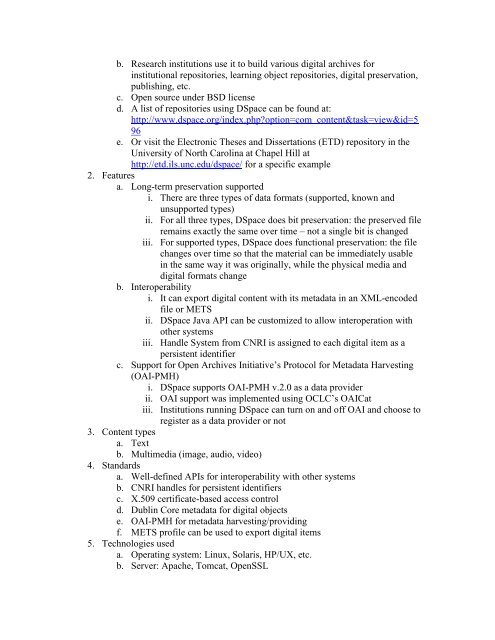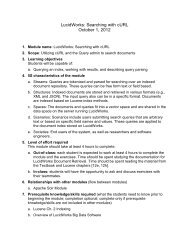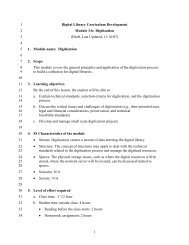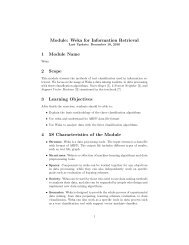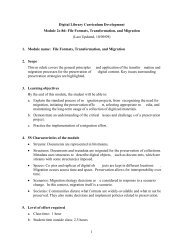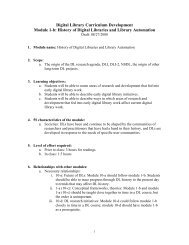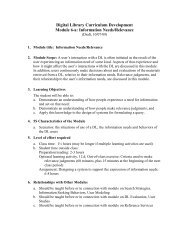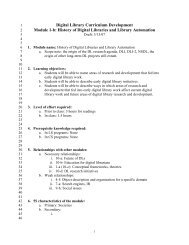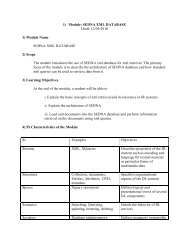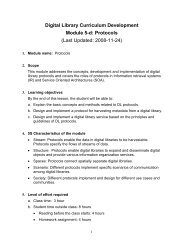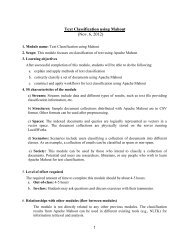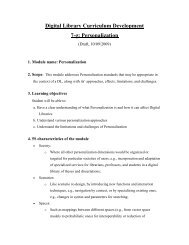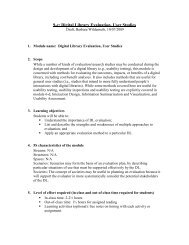1. Module name 2. Scope 3. Learning objectives 4. 5S ...
1. Module name 2. Scope 3. Learning objectives 4. 5S ...
1. Module name 2. Scope 3. Learning objectives 4. 5S ...
- No tags were found...
You also want an ePaper? Increase the reach of your titles
YUMPU automatically turns print PDFs into web optimized ePapers that Google loves.
. Research institutions use it to build various digital archives forinstitutional repositories, learning object repositories, digital preservation,publishing, etc.c. Open source under BSD licensed. A list of repositories using DSpace can be found at:http://www.dspace.org/index.php?option=com_content&task=view&id=596e. Or visit the Electronic Theses and Dissertations (ETD) repository in theUniversity of North Carolina at Chapel Hill athttp://etd.ils.unc.edu/dspace/ for a specific example<strong>2.</strong> Featuresa. Long-term preservation supportedi. There are three types of data formats (supported, known andunsupported types)ii. For all three types, DSpace does bit preservation: the preserved fileremains exactly the same over time – not a single bit is changediii. For supported types, DSpace does functional preservation: the filechanges over time so that the material can be immediately usablein the same way it was originally, while the physical media anddigital formats changeb. Interoperabilityi. It can export digital content with its metadata in an XML-encodedfile or METSii. DSpace Java API can be customized to allow interoperation withother systemsiii. Handle System from CNRI is assigned to each digital item as apersistent identifierc. Support for Open Archives Initiative‘s Protocol for Metadata Harvesting(OAI-PMH)i. DSpace supports OAI-PMH v.<strong>2.</strong>0 as a data providerii. OAI support was implemented using OCLC‘s OAICatiii. Institutions running DSpace can turn on and off OAI and choose toregister as a data provider or not<strong>3.</strong> Content typesa. Textb. Multimedia (image, audio, video)<strong>4.</strong> Standardsa. Well-defined APIs for interoperability with other systemsb. CNRI handles for persistent identifiersc. X.509 certificate-based access controld. Dublin Core metadata for digital objectse. OAI-PMH for metadata harvesting/providingf. METS profile can be used to export digital items5. Technologies useda. Operating system: Linux, Solaris, HP/UX, etc.b. Server: Apache, Tomcat, OpenSSL


